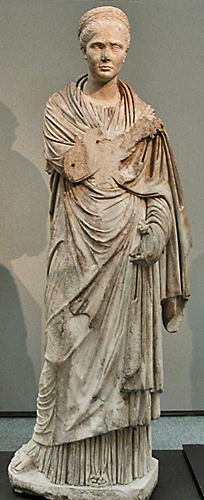 Draped portrait statue, Cyrene, 130 CE
Draped portrait statue, Cyrene, 130 CE
The woman whose modesty and courage is celebrated in this passage lived under the Julio-Claudian emperors, but she is closer in spirit to the aristocratic matronae of the Republican period who adhered to the traditional mores of their class. Seneca the Younger speaks highly of her in a philosophical letter to his mother (42 CE), written to console her from his exile in Corsica where he had been ordered by the emperor Claudius (see WRW 68-71). She is Seneca's esteemed aunt whose name has not been preserved nor has her precise status within the family of the wealthy Annaei. Seneca describes his mother Helvia as an only child (unica; ad Helviam18.9), but refers to his aunt as her sister (soror) and to her husband as his maternal uncle (avunculus is a mother's brother or a mother's sister's husband). Given the complex upper-class family relationships that arose in Rome during the last century BCE because of divorce, death, remarriage and adoptions, Helvia's status as an only child with siblings may be accurate. His aunt or uncle may have been a child of a previous marriage, in which case she would have been Helvia's half-sister or sister-in-law (soror was also used of a cousin). Seneca's aunt accompanied her husband, C. Galerius, to his post as Prefect of the senatorial Roman province of Egypt and remained with him during his term of service (16 to 31 CE) — a custom of wives that was vigorously debated in the Senate in 21 CE (see Tacitus, Annals 3.33-4). Seneca witnessed his aunt's heroism when their ship was wrecked in a storm on their return journey (31 CE), leaving her a widow (see McGinn). She was a surrogate mother at critical moments in his life: carrying him as a child when they migrated from the family home in Corduba (Hispania) to Rome; nursing him as an adult through a life-threatening illness; promoting his campaign for quaestorship after their return from Egypt (ad Helviam19.2). Still attached to the family of the Annaei in 42 CE, she presumably remained unmarried ((see Vnivirae, the honorific for a woman who married only once). Respecting her traditional pudicitia, Seneca memorializes her not by name but as an unicum sanctitatis exemplum.